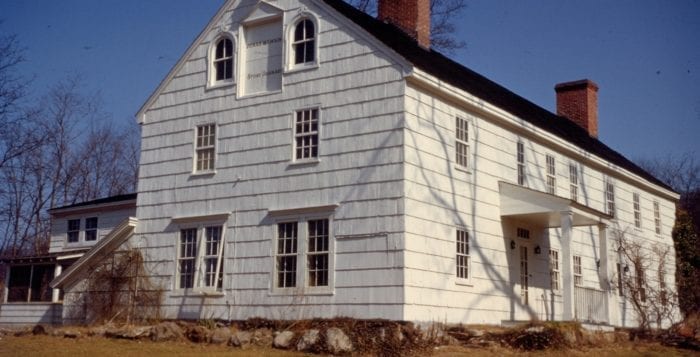Beverly C. Tyler
Part one of two
Major Jonas Hawkins, son of Major Eleazer and Ruth (Mills) Hawkins, was born in Stony Brook, April 28, 1752, in what is now known as the Hawkins-Mount House at the intersection of Route 25A and Stony Brook Road. Jonas Hawkins married his first cousin Ruth Mills, Jan. 1, 1775, a little more than three months before the first shots were fired at Concord and Lexington, Massachusetts, April 18 and 19, 1775 — dates that marked the beginning of the Revolutionary War.
Hawkins was one of 73 men who signed the Association to sustain the Continental Congress and The Provincial Conventional in Brookhaven on June 8, 1775. The men who signed pledged themselves to stand against British tyranny. The list also included Selah Strong and Jonathan and Samuel Thompson who supplied intelligence to Gen. Washington in 1777, before becoming refugees in Connecticut after their spying was discovered.
It appears that during the entire Revolutionary War, Hawkins and his wife remained at their home and farm in Stony Brook as six of their children were born there between 1776 and 1783. It is also known that Hawkins made a number of trips into New York City to gather information that he supplied to Washington through the Setauket-based Culper Spy Ring between January and June 1779. He also needed to make trips to New York City to purchase dry goods and other items that were necessary for the general store and ordinary that he ran out of his home in Stony Brook.
Hawkins’ home was built in 1757, and the loading door on the third-story gable end still reads, “Jonas Hawkins Store and Ordinary.” We don’t know exactly when the general store was started but by 1780, and probably by the end of 1778, it was in full operation with Hawkins making frequent trips to New York City.
The bill of credit below, part of the Three Village Historical Society’s Local History Collection, is one of a number of handwritten bills that indicate the range of products that rural general store merchants stocked and had available. Bills of credit for Hawkins from 1780 through 1784 indicate that he also made purchases from many wholesalers such as “Elijah & Isaac Cock,” “Woodhull and Dickinson,” “Pearsall Glover” and “Willet Seaman.”
“Bought of Peter Smith & co … Brooklyn, N.Y., Nov 17th 1780
5 Razors at l/9 … 8 .. 9 (8 shillinas, 9 pence)
1 gross sleeve buttons 19..
1 Bladder Snuff 4/6 18..7
6 u(units) pepper @ 3/6. 1. .. 1 (1 pound, 1 shilling)
Mr. Jonas Hawkins”
The range of items Hawkins purchased is quite extensive and indicates that local residents, especially after the Revolutionary War (1775–1783), had a wide range of goods available from the country general store. Hawkins, bought quantities of “Callico” (imported cotton textile), “Linnen,” “Superfine cloth” (finely woven linen), “Durant” (a variety of worsted wool),” “Cambruk” (cambric, linen or fine white cotton glazed on one side), “gause, thread, narrow Blk binding, cordarry” (corduroy) and “calimmink” (calamanco — a
European woolen cloth of satin weave in an imitation of camel’s hair).
Hawkins also purchased tea, nutmegs, clover seed, barrels of sugar, raisins, rum, gin, wine and tobacco. From another supplier he received “twist”(mottled woolens), buttons, bibles, pins, writing paper, shoe bindings and sewing silk as well as other cloths called “blue Tabareen” (Tabbinet — an Irish-made poplin), “Blue Morine” (Moreen — a stout, water-embossed finished fabric of wool or wool and cotton) and “black Tafaty” (taffeta — a rich thin silk).
From yet another supplier he received sickles, scythes, pen knives, tobacco boxes and something listed as “1 doz Tomatum.” From Andrew Van Tuyh he received more than 100 yards of green, brown and “mixt German Sarge” (serge) as well as metal buttons and 1 dozen silver spurs. Locally, “Mr. Hawkins bought of Edward Dayton — 8 paire of shoes at 7s (shillings a) pair.”
After the Revolutionary War, the country general store came into its own as an institution. It was an original American idea, an outgrowth of independence, an example of Yankee know-how and frontier enterprise at its best. The general store became part of the Triangle Trade.
Beverly C. Tyler is Three Village Historical Society historian and author of books available from the society at 93 North Country Road, Setauket. For more information, call 631-751-3730 or visit www.tvhs.org.





